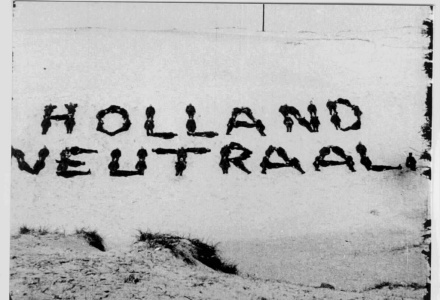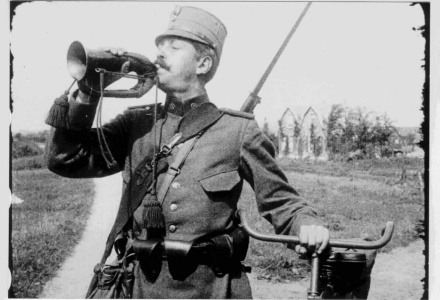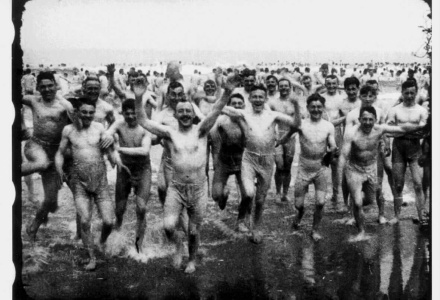Leger- en vlootfilm
Summary
Propaganda Film About the Dutch Military.
Holland neutraal (Neutral Holland) is this film’s subtitle, which was meant to show that the Dutch armed forces are very much prepared to guarantee the Netherlands’ neutrality in World War One. The more than 2.5-hour film was made by Willy Mullens in 1917, when other Western European armies had become numbed after three long years in the trenches. The footage in the Army and Navy Film depicts a relatively high-spirited mood, considering how the Dutch military had mobilized but not actually participated in the war.
Mullens mainly shows the various military divisions performing exercises. All manner of subjects are touched upon: sports, the military cyclists, army dogs, the Dutch Red Cross, supplies, the handling of animals, laundry, mine-laying, the cavalry, the engineering corps, hand-grenade throwing, a munitions factory, theatre, an autoradiography station, motorcyclists, submarines, and signalling. The ten parts into which (the director claims) the film has been divided into are not indicated with intertitles, nor can they be distinguished in terms of content. Only the last two parts, which together form the ‘Navy’ film, clearly belong together. The exercises are performed patiently and cheerfully. The threat of war seems far away, although Queen Wilhelmina is emphatically present at various moments in the film, including during the inspection of the hussars. She also vigorously rides horseback using an impractical woman’s side-saddle (seeing as a Queen did not wear trousers). An almost touching naiveté emerges from some of the shots; for example how one by one, the cyclists cross a canal using a cable, carrying their bicycles as they go. We also see the military brass band lugging their huge drum and heavy copper as they cross a narrow pontoon bridge, and a mass of soldiers sticking their fingers in their ears when artillery is fired. Also of note is the large role played by dogs, horses, and carrier pigeons in the army. The training, care, and nursing of these animals features prominently in the film.
Precisely who it was that needed to be convinced of the solid foundation of the Netherlands’ neutrality is shown clearly in a folder that accompanied the screening of this film in The Hague’s Residentie-Bioscoop: ‘The purpose of the film is to impress upon the Dutch people, the people of our Colonies, and those abroad, that our military forces, with the resources at their disposal, can readily be compared to those of the foreign military forces.’ The term ‘impress upon’ can be taken literally: people needed to be put at ease. Commander in Chief C.J. Snijders in particular was always painfully blunt about his belief that the Netherlands’ neutrality was ultimately unsustainable. Snijders had repeatedly suggested seeking an alliance with Germany, because the example of Belgium had shown that resisting, in the case of a confrontation, would be a lost cause.
This standpoint – which became even more vehement in 1918 – would also make Snijders one of the most controversial figures in this chapter of Dutch history. The folder remains optimistic: ‘Too often the focus is on what happens beyond our borders, and too greatly are our own shortcomings magnified.’ In other words, a certain degree of insularity was necessary to avoid defeatism.
Information
Images
Crew
- Director
- Producer
- Camera
- Initiator (corp)
Technical notations
Resources
Catalogus van Filmwerken - H.A.P. & BenS Film Comp.,Den Haag (1923), p. 25
1899 - 1949. Gouden Jubileum van Willy Mullens en 50 Jaar Cinematografie in Nederland (1949)
B. Hogenkamp, De Nederlandse documentaire film 1920-1940, Amsterdam (1988), pp.10-11, p. 135
De Bioscoop-Courant No. 46, 4 augustus 1916, p. 14
De Bioscoop-Courant No. 47, 11 augustus 1916, p. 7
De Bioscoop-Courant No. 14, 29 december 1916, p. 15
De Bioscoop-Courant No. 15, 5 januari 1917, p. 8, pp. 13-20
De Bioscoop-Courant No. 16, 12 januari 1917, p. 4
De Bioscoop-Courant No. 17, 19 januari 1917, p. 8, p. 14, p. 16
Filma's Weekbericht No. 96, Bijlage bij De Bioscoop-Courant No. 17, 19 januari 1917
De Bioscoop-Courant No. 18, 26 januari 1917, pp. 15-16
De Bioscoop-Courant No. 22, 23 februari 1917, p. 12
Filma's Weekbericht No. 103, Bijlage bij De Bioscoop-Courant No. 24, 9 maart 1917
De Bioscoop-Courant No. 51, 13 september 1918; Bijlage van De Bioscoop-Courant
Algemeen Handelsblad, 7 januari 1917
Algemeen Handelsblad, 11 januari 1917
Algemeen Handelsblad, 13 januari 1917
Nieuws van de Dag, 13 januari 1917
Het Volk, 13 januari 1917
De Tijd, 7 februari 1917
De Kinematograaf No. 187, 18 augustus 1916, p. 2457
De Kinematograaf No. 206, 29 december 1916
De Kinematograaf No. 299, 11 oktober 1918, p. 4064
Kunst en Amusement No. 15, 1921
more information
If you are looking for more material from our collection, please contact Film Sales:
sales@eyefilm.nl
phone +31 (0)20 5891 426





